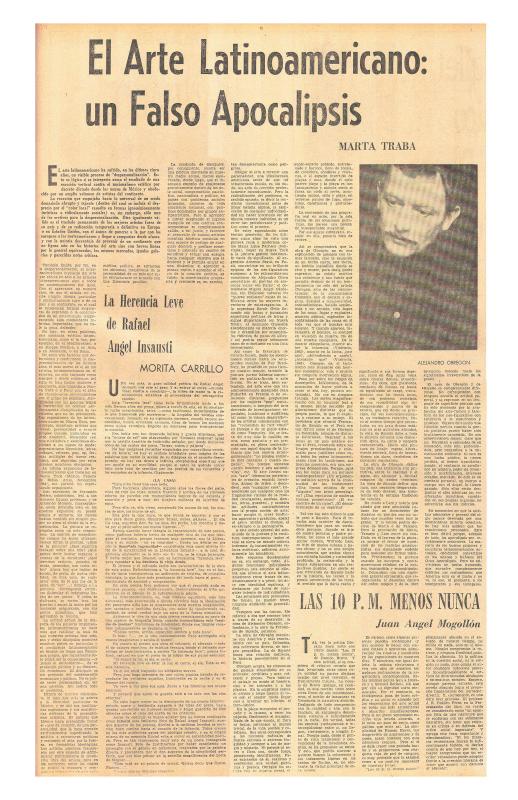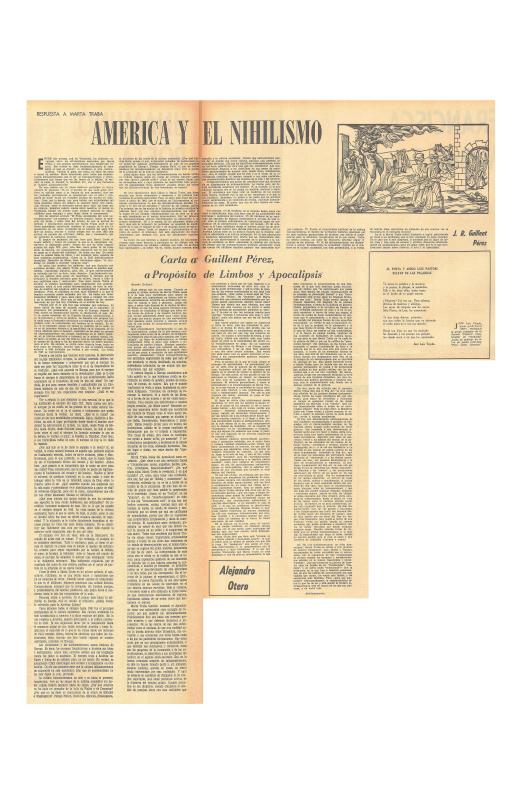This article is an integral part of the debate that began with the publication of “El arte latinoamericano: un falso apocalipsis,” an article by the art critic Marta Traba (1923–83) in Papel Literario—the Caracas newspaper El Nacional’s weekly supplement—on May 2, 1965 [see doc. no. 799377]. The main Venezuelan participants in the debate, which dragged on until about September of that year, included J. R. Guillent Pérez, Alejandro Otero, Roberto Guevara, and Alirio Rodríguez, as well as, of course, Marta Traba. The controversy spilled over into other media, such as the Revista Nacional de Cultura, and was the subject of radio and television appearances, as well as conferences and discussions.
The articles that appeared in the Papel Literario supplement of El Nacional newspaper were assembled into the Colección Delta Solar as Modernidad y postmodernidad. Espacios y tiempos dentro del arte latinoamericano (Caracas: Museo Alejandro Otero, 2000). A selection of the articles that appeared in the Revista Nacional de Cultura was published in Roldán Esteva-Grillet’s (Compiler) Fuentes documentales y críticas de las artes plásticas venezolanas. Siglos XIX y XX (Caracas, CDCH/UCV, Vol. II, 2001).
This second and final article written by the Venezuelan painter Alejandro Otero (1921–90) as part of the debate is particularly valuable because of the author’s summary of the ideas proposed by Marta Traba; Otero diligently rejects Traba’s ideas, which were a fundamental part of the debate. After re-stating his original proposals, Otero expands on his reasons for adhering to a universal kind of art based on a desire to find a “level playing field” where Latin American and western intellectual concerns can meet. He also describes the complexity of artistic creation as a product of intuitive and secret processes, a concept that is diametrically opposed to the idea that creation flows from a preconceived nationalist intention as, in his interpretation, Traba suggests.
This article becomes personal when Otero addresses Traba directly, something he did not do in his first article (“Carta a Guillent Pérez, a propósito de limbos y apocalipsis” [doc. no. 798998]) which, as an open letter published in the newspaper, merely states his general disagreements with Traba’s ideas concerning a “nationalist” role for art. In his second article his language takes on a harsher, more defensive tone, and he not only attacks her ideas but her lack of professional ethics as well. He presents the correspondence that he and Traba exchanged some years ago in order to show how she contradicts herself about his work. In those letters, in fact, Traba does express her admiration for Otero’s work, which he uses to criticize her in their current disagreement.


